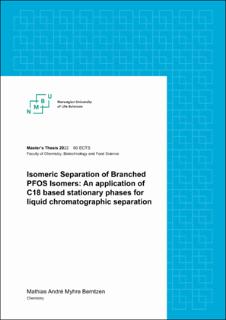| dc.contributor.advisor | Kallenborn, Roland Peter | |
| dc.contributor.author | Berntzen, Mathias André Myhre | |
| dc.date.accessioned | 2022-12-19T09:54:56Z | |
| dc.date.available | 2022-12-19T09:54:56Z | |
| dc.date.issued | 2022 | |
| dc.identifier.uri | https://hdl.handle.net/11250/3038438 | |
| dc.description.abstract | Perfluorooctanesulfonate (PFOS) is a synthetic chemical that persist ubiquitously in waters and soils all over the world. PFOS has since its invention in the 1950 been one of the most produced per- and polyfluorinated alkylated substances (PFAS). The physical and chemical properties of PFOS is the reason it has been utilized in industrial sectors and household items as surfactants. The large area of applicability has consequently given multiple contamination sources. As a result of PFOS persistency in nature and links to multiple negative health effects, PFOS is classified as a persistent organic pollutant. A process called electrochemical fluorination (ECF) is the most common way to synthesize PFOS. This process synthesizes approximately 70% linear PFOS (L-PFOS) in addition to approximately 30% branched isomers of PFOS (Br-PFOS).
The objective of this study was to develop and validate an analytical method for quantification and separation of L-PFOS and 7 Br-PFOS isomers found in the technical product of PFOS by ECF. The analytical method was developed on a high-performance liquid chromatography tandem mass spectrometry (HPLC-MS/MS) instrument with an ACE Excel C18- PentaFluoroPhenyl (PFP) column. The method will attempt to quantitate the PFOS isomers individually in freshwater samples from a river in Fjellhamar, a lake called Sogna in Kjeller and run-off water from Ny-Ålesund to create an isomer profile for each location. The sample locations have possibilities of PFOS contamination from Aqueous Film-Forming Foam which is a major contamination source.
The method was validated and managed to separate the target isomers into 5 groups of PFOS, whereas 3 of them were single separated isomers, while the remaining 2 peaks consisted of coeluted isomers. Each group was treated as analytes and was applied to quantitate PFOS isomers in the water samples.
Both L-PFOS and Br-PFOS were detected at all sites proving that each study site had PFOS contamination. Some of the analytes were not at a detectable or quantifiable level in the samples from Fjellhamar river and Sogna, which showed that the method has sensitivity issues at low concentrations. All isomers were quantified in Ny-Ålesund, but some exceeded the linear range of the analytical method. The isomer profiles from all study sites found the contribution of L-PFOS to be below 60%, which provided insight in Br-PFOS different physical and chemical properties compared to L-PFOS. | en_US |
| dc.description.abstract | Perfluoroktylsulfonat (PFOS) er et syntetisk kjemikalie som finnes i vann og jord over hele verden. PFOS har siden sin oppfinnelse i 1950 vært en av de mest produserte per- og polyfluoralkyl stoffene. På grunn av sine fysiske og kjemiske egenskaper, er PFOS brukt særlig i industriell sektor og i husholdningsartikler som overflateaktivt middel. Det store bruksområdet har medført flere kilder til forurensing. Grunnet PFOS sin lange holdbarhet i naturen og kobling til flere negative helseeffekter, har PFOS blitt klassifisert som en persistent organisk miljøgift. En prosess kalt elektrokjemisk fluorering (ECF) er den vanligste måten å syntetisere PFOS på. Denne prosessen syntetiserer omtrent 70% lineær PFOS (LPFOS), i tillegg til omtrent 30% forgrenede isomerer av PFOS (Br-PFOS).
Målet ved denne studien var å utvikle og validere en analytisk metode for kvantifisering og separering av L-PFOS og 7 Br-PFOS isomerer funnet i det tekniske produktet av PFOS ved hjelp av ECF. Den analytiske metoden ble utviklet for et høy-presisjons væskekromatografi tandem massespektrometer (HPLC-MS/MS), et instrument med en ACE Excel C18- pentafluorfenyl (PFP) kolonne. Denne metoden vil forsøke å kvantifisere PFOS isomerene individuelt i ferskvannsprøver fra en elv i Fjellhamar, innsjøen Sogna på Kjeller og avløpsvann fra Ny-Ålesund, hvor målet er å lage en isomer profil for hvert sted. Prøvetakingslokalitetene kan muligens være kontaminert av PFOS holdig brannskum (AFFF), som er en stor forurensningskilde til PFOS.
Metoden ble validert og klarte å separere målisomerene i fem grupper av PFOS, hvor tre av dem var enkelt separerte isomerer, mens de gjenstående to toppene besto av koeluerte isomerer. Hver gruppe ble behandlet som enkelte analytter og ble brukt for å kvantifisere PFOS isomerer i vannprøvene.
Både L-PFOS og Br-PFOS ble detektert på alle lokalitetene. Dermed ble det vist at hvert prøveområde hadde PFOS forurensing. I vannprøvene fra Fjellhamarelven og Sogna hadde noen av analyttene ikke målbare eller kvantifiserbare nivåer av PFOS, noe som viste at metoden har sensitivitetsproblemer ved lave konsentrasjoner. Alle isomerene ble kvantifisert i prøven fra Ny-Ålesund, men noen overskred den lineære rekkevidden av den analytiske metoden. Fra isomerprofilene fra alle prøveområdene ble det funnet at bidraget fra L-PFOS var under 60%, noe som ga innsikt i Br-PFOS ulike fysiske og kjemiske egenskaper sammenlignet med L-PFOS. | en_US |
| dc.language.iso | eng | en_US |
| dc.publisher | Norwegian University of Life Sciences, Ås | en_US |
| dc.rights | Attribution-NonCommercial-NoDerivatives 4.0 Internasjonal | * |
| dc.rights.uri | http://creativecommons.org/licenses/by-nc-nd/4.0/deed.no | * |
| dc.title | Isomeric separation of branched PFOS isomers : an application of C18 based stationary phases for liquid chromatographic separation | en_US |
| dc.type | Master thesis | en_US |
| dc.relation.project | Norges forskningsråd: 268258 | en_US |
| dc.description.localcode | M-KJEMI | en_US |

